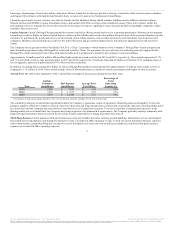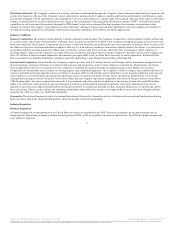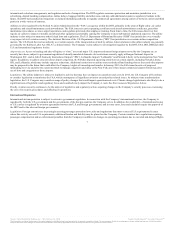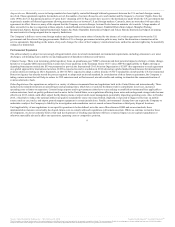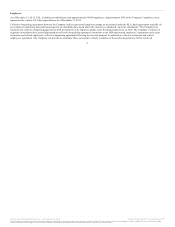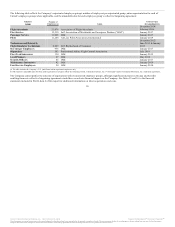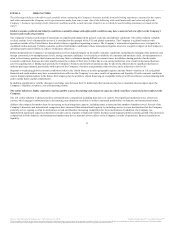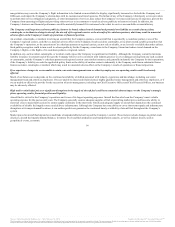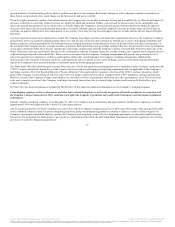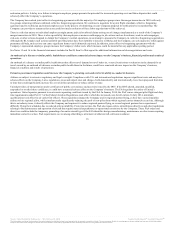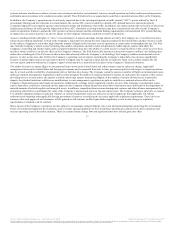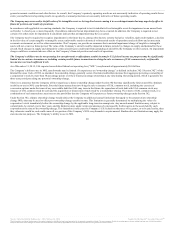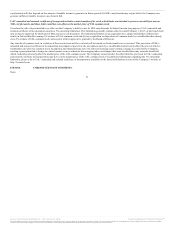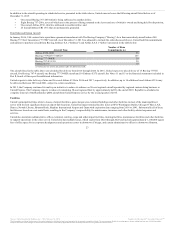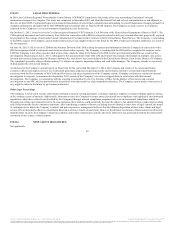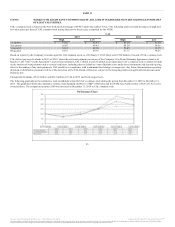United Airlines 2015 Annual Report Download - page 16
Download and view the complete annual report
Please find page 16 of the 2015 United Airlines annual report below. You can navigate through the pages in the report by either clicking on the pages listed below, or by using the keyword search tool below to find specific information within the annual report.
growth indicators, fiscal/monetary policies, fuel tax policies and financial investments. Both actual changes as well as changes in market expectations of
these factors can potentially drive rapid changes in fuel price levels and price volatility.
Given the highly competitive nature of the airline industry, the Company may not be able to increase its fares and fees sufficiently to offset the full impact of
increases in fuel prices, especially if these increases are significant, rapid and sustained. Further, such fare and fee increases may not be sustainable, may
reduce the general demand for air travel and may also eventually impact the Company’s strategic growth and investment plans for the future. In addition,
decreases in fuel prices for an extended period may result in increased industry capacity, increased competitive actions for market share and lower fares or
surcharges in general. If fuel prices were subsequently to rise quickly, there may be a lag between improvement of revenue and the adverse impact of higher
fuel prices.
To protect against increases in the market prices of fuel, the Company may hedge a portion of its future fuel requirements. However, the Company’s hedging
program may not be successful in mitigating higher fuel costs, and any price protection provided may be limited due to choice of hedging instruments and
market conditions, including breakdown of correlation between hedging instrument and market price of aircraft fuel and failure of hedge counterparties. To
the extent that the Company decides to hedge a portion of its future fuel requirements and uses hedge contracts that have the potential to create an obligation
to pay upon settlement if fuel prices decline significantly, such hedge contracts may limit the Company’s ability to benefit fully from lower fuel costs in the
future. If fuel prices decline significantly from the levels existing at the time the Company enters into a hedge contract, the Company may be required to post
collateral (margin) beyond certain thresholds. There can be no assurance that the Company’s hedging arrangements will provide any particular level of
protection against rises in fuel prices or that its counterparties will be able to perform under the Company’s hedging arrangements. Additionally,
deterioration in the Company’s financial condition could negatively affect its ability to enter into new hedge contracts in the future and may potentially
require the Company to post increased amounts of collateral under its fuel hedging agreements.
The Dodd-Frank Wall Street Reform and Consumer Protection Act of 2010 and regulations promulgated by the Commodity Futures Trading Commission (the
“CFTC”) require centralized clearing for over-the-counter derivatives and record-keeping and reporting requirements that are applicable to the Company’s
fuel hedge contracts. The UAL Board of Directors (“Board of Directors”) has approved the Company’s election of the CFTC’s end-user exception, which
permits the Company as a non-financial end user of derivatives to hedge commercial risk and be exempt from the CFTC mandatory clearing requirements.
However, several of the Company’s hedge counterparties are also subject to these requirements, which may raise the counterparties’ costs. Those increased
costs may in turn be passed on to the Company, resulting in increased transaction costs to execute hedge contracts and lower credit thresholds to post
collateral (margin).
See Note 10 to the financial statements included in Part II, Item 8 of this report for additional information on the Company’s hedging programs.
Union disputes, employee strikes or slowdowns, and other labor-related disruptions, as well as the integration of United’s workforces in connection with
the Company’s merger transaction in 2010, could adversely affect the Company’s operations and could result in increased costs that impair its financial
performance.
United is a highly unionized company. As of December 31, 2015, the Company and its subsidiaries had approximately 84,000 active employees, of whom
approximately 80% were represented by various U.S. labor organizations.
The successful integration of United’s workforces in connection with the Company’s merger transaction in 2010 and achievement of the anticipated benefits
of the combined company depend in part on integrating employee groups and maintaining productive employee relations. In order to fully integrate the
Company’s pre-merger represented employee groups, the Company must negotiate a joint collective bargaining agreement covering each combined group.
The process for integrating the labor groups is governed by a combination of the RLA, the McCaskill-Bond Amendment, and where applicable, the existing
provisions of collective bargaining agreements
15
Source: United Continental Holdings, Inc., 10-K, February 18, 2016 Powered by Morningstar® Document Research℠
The information contained herein may not be copied, adapted or distributed and is not warranted to be accurate, complete or timely. The user assumes all risks for any damages or losses arising from any use of this information,
except to the extent such damages or losses cannot be limited or excluded by applicable law. Past financial performance is no guarantee of future results.


